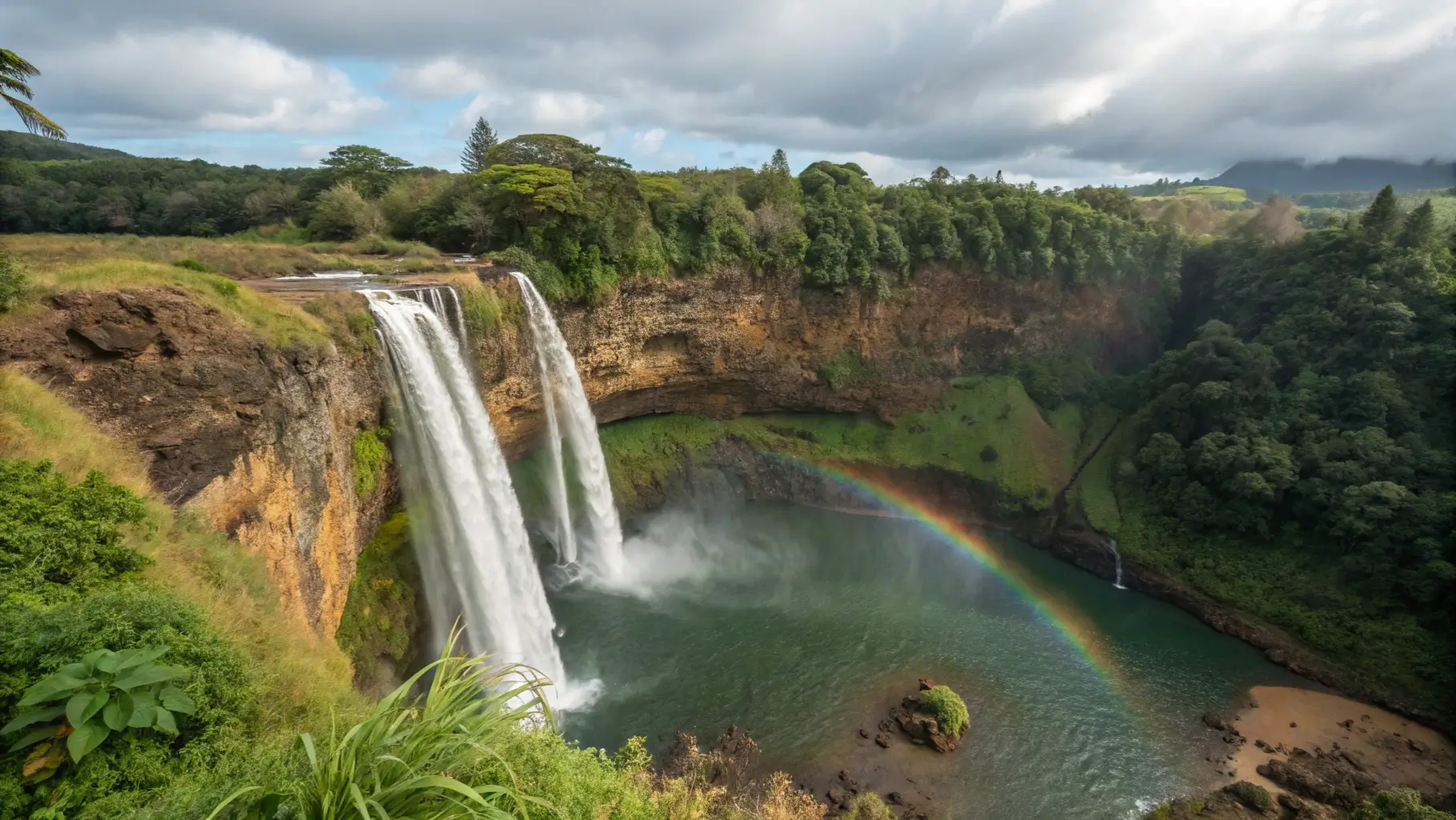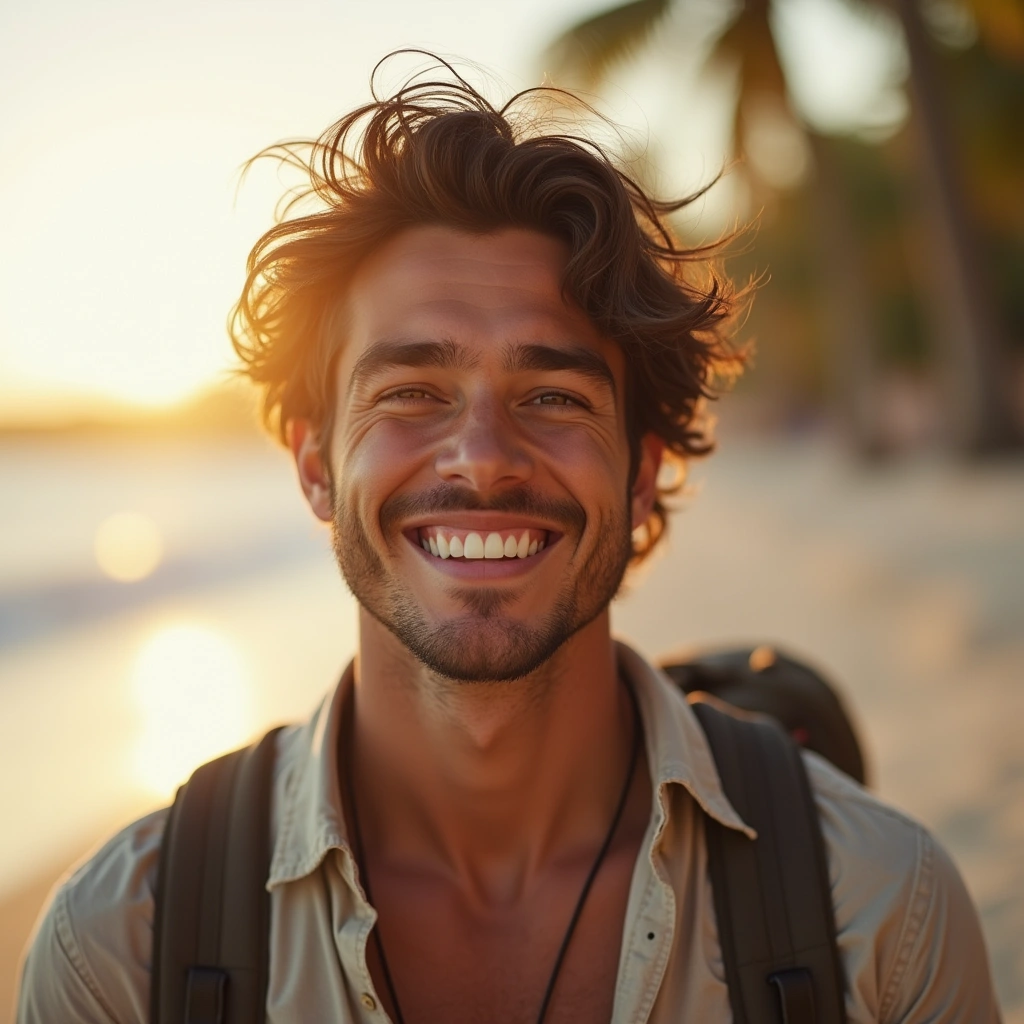Last Updated: May 15, 2025
Introduction: The Majesty of Wailua Falls
Cascading dramatically over an ancient cliff face, wailua falls kauai sends crystalline waters plunging 173 feet into a misty, emerald pool below. This isn’t just any waterfall—it’s one of Kauai’s most accessible yet captivating natural wonders, where the raw power of nature creates a symphony of sights and sounds that has entranced visitors for generations.
Standing at the viewpoint, you’ll feel the gentle mist on your face as rainbows dance through the spray on sunny days. The falls’ distinctive double streams (which sometimes merge into one during heavy rains) create a photogenic tableau that has made Wailua Falls the unofficial poster child for Kauai’s lush, tropical splendor.
Made famous as the backdrop in the opening credits of the hit 1970s TV show “Fantasy Island,” Wailua Falls carries both Hollywood fame and deep cultural significance to Native Hawaiians, who considered these waters sacred. Ancient legends tell of warriors proving their bravery by leaping from the top—a practice that thankfully remains firmly in the past.
Table of Contents
| Wailua Falls Quick Facts | |
| Height | 173 feet (80 feet during dry season) |
| Location | Near Lihue, East Kauai |
| GPS Coordinates | 22.0361° N, 159.3786° W |
| Accessibility | Viewing platform accessible by car |
| Entrance Fee | Free |
| Best Time to Visit | Early morning (7-9am) for rainbows and fewer crowds |
| Facilities | Limited parking, no restrooms |
| Hiking to Bottom | Officially prohibited for safety reasons |
| Swimming | Not permitted due to dangers |
| Visit Duration | 20-60 minutes typically |
Planning Your Visit: Everything You Need to Know
Getting There (Unparalleled Detail)
wailua falls kauai sits at the south end of the Wailua River, nestled in the lush interior of Kauai. Unlike many of Hawaii’s natural treasures that require strenuous hiking, Wailua Falls is remarkably accessible—just a short drive from the main highway with views available right from the parking area.
From Lihue (15-20 minutes):
- Head north on Highway 56 (Kuhio Highway)
- Turn right onto Ma’alo Road (Highway 583)
- Follow Ma’alo Road for approximately 3 miles
- The road ends at the falls viewpoint and parking area
From Poipu (30-35 minutes):
- Take Poipu Road to Koloa Road
- Continue onto Maluhia Road (Tree Tunnel)
- Turn right onto Kaumualii Highway (Highway 50)
- Turn left onto Kuhio Highway (Highway 56)
- Turn right onto Ma’alo Road (Highway 583)
- Follow Ma’alo Road for approximately 3 miles to the falls
From North Shore/Princeville (45-60 minutes):
- Take Kuhio Highway (Highway 56) south
- Pass through Kapaa and continue toward Lihue
- Turn left onto Ma’alo Road (Highway 583)
- Follow Ma’alo Road for approximately 3 miles to the falls
Parking Situation (Critical Information):
- The official parking lot is small, with only about 15-20 spaces
- Arrive before 9am or after 3pm to avoid the rush
- During peak season (June-August, December-January), the lot often fills by 10am
- If the lot is full, limited shoulder parking is available along Ma’alo Road (ensure all wheels are off the pavement)
- Never block the road or other vehicles
- Theft can be an issue—leave no valuables visible in your car
Tour Options: Several tour companies include wailua falls kauai in their itineraries:
| Tour Company | Tour Type | Pros | Cons |
| Kauai Backcountry Adventures | Full-day waterfall tour | Additional stops, knowledgeable guides | Higher price point ($150+) |
| Tread Lightly Kauai | Half-day east side tour | Cultural insights, smaller groups | Limited time at each stop |
| Ali’i Kauai Tours | Photography-focused tour | Timing for best light, photo tips | Less historical information |
| Roberts Hawaii | Island circle tour | Comprehensive, comfortable vehicles | Less time at falls, larger groups |
Public Transportation:
- Limited options exist
- The Kauai Bus does not service Ma’alo Road, You can review current Kauai Bus schedules and routes here.
- Rideshare (Uber/Lyft) is available from major towns but can be expensive (approximately $30-50 one-way from Lihue) and you’ll need return transportation
Best Times to Visit (Data-Driven & Experiential)

Timing your visit to Wailua Falls can significantly impact your experience. Consider these factors when planning:
Time of Day:
- Early Morning (7-9am): The holy grail for photographers. Morning light creates vibrant rainbows in the mist, and you’ll likely have more solitude.
- Mid-day (10am-2pm): Busiest time, with tour buses and highest crowd levels. The bright overhead sun creates harsh lighting conditions for photos.
- Late Afternoon (3-5pm): Crowds thin, and softer light returns, though rainbows are less common than mornings.
Seasonal Considerations:
| Season | Water Flow | Crowd Level | Weather |
| Winter (Dec-Feb) | Highest volume, most dramatic | Moderate-High | More rain, occasional view obstruction |
| Spring (Mar-May) | Good flow, gradually decreasing | Moderate | Improving weather, good balance |
| Summer (Jun-Aug) | Lowest volume, sometimes single stream | Highest | Driest, consistent views |
| Fall (Sep-Nov) | Gradually increasing with fall rains | Lowest | Variable, can be ideal |
Average Monthly Rainfall Near wailua falls kauai:
| Month | Average Rainfall (inches) |
| January | 5.8 |
| February | 5.2 |
| March | 6.4 |
| April | 4.8 |
| May | 3.7 |
| June | 2.3 |
| July | 2.6 |
| August | 2.9 |
| September | 3.2 |
| October | 4.6 |
| November | 5.9 |
| December | 6.5 |
Crowd Levels by Day:
- Weekdays: Typically 30-40% fewer visitors than weekends
- Weekends: Peak around 11am-1pm
- Holidays: Extremely busy, especially during Christmas/New Year and summer holidays
What to Expect
The Viewing Platform: The main viewing area is a simple paved platform with a low stone wall at the edge of the parking area. It provides a clear, straight-on view of the falls from above and across the gorge.
- Accessibility: The viewing area is wheelchair accessible from the parking lot with a flat, paved surface
- Safety: The wall is low (about 3 feet high), so keep children under close supervision
- Photography: Unobstructed views, though limited to one primary angle
Facilities: Wailua Falls is intentionally kept in a natural state, which means amenities are minimal:
- Restrooms: None at the falls (nearest public restrooms are at Wailua River State Park, about 3 miles away)
- Water fountains: None (bring your own water)
- Vendors: Occasionally, local vendors sell fruit, coconuts, or handicrafts from trucks in the parking area (cash only, not reliable)
- Shelter: No covered areas in case of rain
Time Needed: Most visitors spend between 20-60 minutes at wailua falls kauai:
- 5-10 minutes: Quick stop for photos
- 20-30 minutes: Average visit, taking photos and enjoying the view
- 45-60 minutes: Photography enthusiasts capturing different lighting conditions
The Wailua Falls Experience: Beyond Just a Viewpoint
Photography Guide
Wailua Falls is among Kauai’s most photogenic locations, but capturing its grandeur requires some planning and technique.
Best Angles from the Viewpoint:
- Classic Frontal: From the center of the viewing area, capturing both streams
- Side Angle: Move to the far right of the viewing area for a more dramatic perspective
- Zoom Focus: Using a telephoto lens to capture the pool where the water lands
- Wide Angle: Include the surrounding canyon walls and vegetation for scale
Recommended Camera Settings:
| Scenario | Aperture | Shutter Speed | ISO | Notes |
| Standard Daylight | f/8-f/11 | 1/125 sec | 100-200 | Use polarizing filter to reduce glare |
| Flowing Water Effect | f/16-f/22 | 1/15-1/4 sec | 100 | Requires tripod, neutral density filter helpful |
| Rainbow Capture | f/8 | 1/250 sec | 100-200 | Slight underexposure helps rainbow colors pop |
| Golden Hour | f/5.6-f/8 | 1/60 sec | 200-400 | Warm white balance setting enhances golden tones |
Equipment Recommendations:
- Beginner: Smartphone with HDR mode, mini tripod or stable surface
- Intermediate: DSLR/Mirrorless with 24-70mm lens, polarizing filter, tripod
- Advanced: Add 70-200mm telephoto lens, neutral density filters, remote shutter release
Rainbow Photography Tips:
- Position yourself with the sun at your back
- Visit between 7-9am for optimal rainbow conditions
- Look for rainbows after brief rain showers
- Slight underexposure often makes rainbows more vibrant
- Use a polarizing filter to enhance or reduce rainbow intensity
Hiking & Access (The TRUTH – with extreme caution)
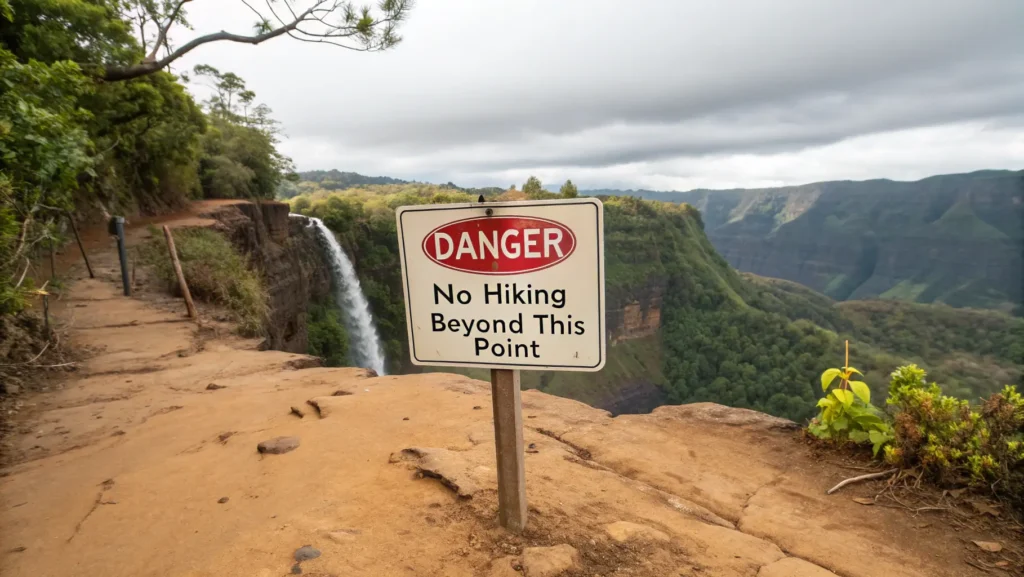
One of the most frequently asked questions about wailua falls kauai is whether visitors can hike to the bottom. This requires a straightforward and responsible answer:
Official Status: Hiking to the bottom of Wailua Falls is prohibited and dangerous.
The State of Hawaii and Kauai County officials have explicitly forbidden hiking to the base of the falls for several critical reasons:
- Serious Safety Hazards:
- The unofficial trail is extremely steep and slippery, with a near-vertical descent in places
- The clay soil becomes treacherously slick when wet (which is frequent in this rainforest environment)
- Rockfalls from the cliff face are common and unpredictable
- Flash floods can occur with little warning
- Documented Incidents:
- Multiple serious injuries occur annually
- At least five fatalities have been recorded since 2000
- Rescue operations are complex and dangerous for first responders
- Environmental Impact:
- Erosion from unofficial trails damages the fragile ecosystem
- Increased foot traffic disrupts native species and introduces invasive plants
- Cultural Respect:
- The area has cultural significance to Native Hawaiians
Enforcement and Consequences:
- The area is periodically patrolled
- Trespassing can result in fines up to $1,000
- If rescue is required, you may be billed for the cost of emergency services
While you may find online accounts or see people attempting this hike, as responsible travelers, we must respect both the law and the ‘āina (land). The views from the official lookout are spectacular and safe—please enjoy Wailua Falls responsibly.
History & Legends
Wailua Falls carries deep cultural significance that extends far beyond its natural beauty and Hollywood fame.
Ancient Hawaiian Significance: The waters of Wailua Falls were considered sacred by Native Hawaiians. The Wailua River valley, including the falls, was known as a royal center and one of the most important areas on Kauai. The name “Wailua” translates roughly to “two waters,” possibly referring to the falls’ double streams or the river’s two branches.
During ancient times, the area around Wailua Falls was kapu (forbidden) to all but ali’i (royalty) and priests. Archaeological evidence suggests ceremonial sites existed near the falls, though exact details have been lost to time.
The Legend of the Leaping Warriors: One of the most enduring legends about Wailua Falls involves ancient Hawaiian warriors. According to tradition, young men would leap from the top of the falls into the pool below as a test of courage and strength. Those who survived the 173-foot plunge were considered especially brave and worthy. While this practice is mentioned in several historical accounts, it’s important to note that even skilled cliff divers today would consider such a jump extremely dangerous due to the varied water depths and hidden rocks.
The “Fantasy Island” Connection: Wailua Falls gained international fame when it was featured in the opening credits of the popular television series “Fantasy Island,” which ran from 1977 to 1984. As the show’s theme music played, viewers were treated to a dramatic aerial shot of the falls, which became one of the most recognizable images of Hawaii in popular culture.
Behind-the-scenes trivia: The production crew originally planned to use multiple Hawaii locations in the opening sequence but were so impressed by Wailua Falls that they decided to make it the primary visual. Interestingly, while the falls were filmed on Kauai, most of the actual show was filmed in California.
Historical Changes: Old photographs and accounts from the early 20th century show that the area around Wailua Falls was once much less accessible, requiring a hike through dense forest. The road and viewing area were developed in the 1970s, coinciding with increased tourism to Kauai. This development dramatically changed visitation patterns, transforming a once-remote natural wonder into one of the island’s most visited sites.
Flora, Fauna & Geology
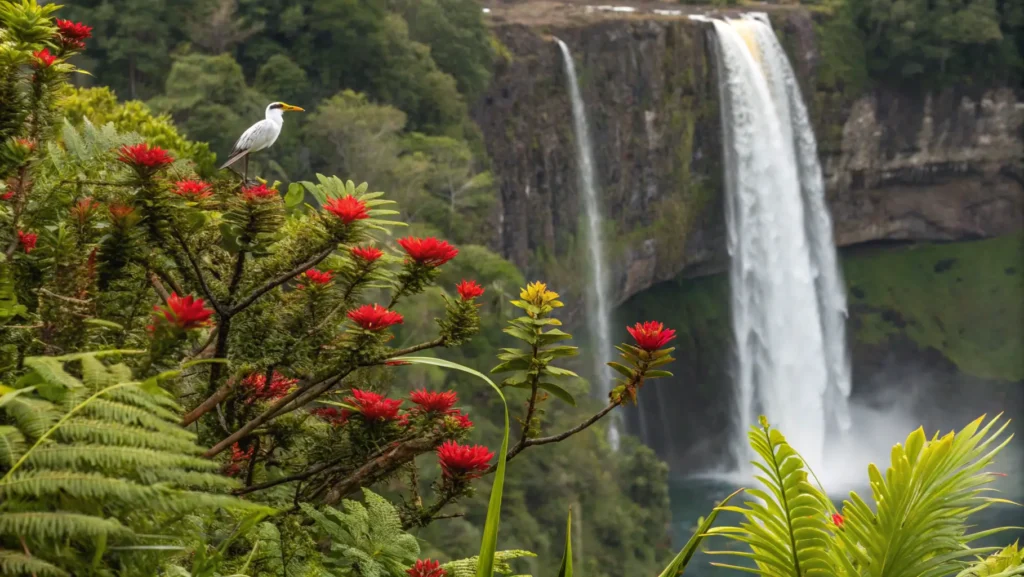
The ecosystem surrounding Wailua Falls represents a microcosm of Kauai’s unique natural environment, shaped by millions of years of geographic isolation and volcanic activity.
Geological Formation: Wailua Falls cascades over a cliff face formed from Koloa Volcanic Series basalt, dating back approximately 1.5 million years. The falls mark a transition zone between Kauai’s older central volcanic mountains and the younger coastal plain. Over millennia, the Wailua River has carved this dramatic gorge, with the falls gradually retreating upstream due to erosion.
The distinctive double-stream formation occurs because erosion has created a small island of harder rock at the center of the river’s path, splitting the water flow. During heavy rains, the increased water volume can merge these streams into one impressive torrent.
Flora: The vegetation around Wailua Falls represents a mix of native Hawaiian plants and introduced species:
- Native Plants:
- ‘Ōhi’a Lehua (Metrosideros polymorpha) – Sacred flowering trees with red blossoms
- Koa (Acacia koa) – Valuable hardwood trees with sickle-shaped leaves
- Hāpu’u (Hawaiian Tree Fern) – Prehistoric-looking giants that can grow 25 feet tall
- Ti plants (Cordyline fruticosa) – Culturally significant plants with broad, green leaves
- Introduced Species:
- Mango trees (Mangifera indica)
- African tulip trees (Spathodea campanulata) – Recognizable by their bright orange flowers
- Bamboo (Various species) – Growing along the river edges
Fauna: The area around Wailua Falls hosts diverse wildlife, particularly birds:
- Native Birds:
- ‘Apapane (Himatione sanguinea) – Small crimson birds that feed on ‘ōhi’a nectar
- Hawaiian Hawk or ‘Io (Buteo solitarius) – Endangered raptor occasionally seen soaring overhead
- Introduced Birds:
- White-rumped Shama (Copsychus malabaricus) – Known for beautiful song
- Japanese White-eye (Zosterops japonicus) – Tiny birds with distinctive white eye rings
- Common Myna (Acridotheres tristis) – Often seen in the parking area
- Aquatic Life:
- ‘O’opu (Hawaiian Goby) – Native fish that have the remarkable ability to climb waterfalls
- Prawns and small crustaceans in the pool below
Microclimate: The waterfall creates its own microclimate, with slightly cooler temperatures and higher humidity than surrounding areas. This unique environment supports specialized mosses and ferns that thrive in the constant mist from the falls.
Safety & Respectful Tourism
Staying Safe at the Viewpoint
While Wailua Falls is one of Kauai’s most accessible natural attractions, safety should remain a priority:
- Stay behind barriers: The official viewing area has low walls for a reason—the cliffs are unstable and dangerous
- Weather awareness: Surfaces become extremely slippery during and after rain
- Child supervision: Keep children within arm’s reach due to the low wall and steep drop-offs
- Parking area: Be cautious of cars entering and leaving, as the small lot can get congested
- Flash floods: If heavy rain begins falling, be aware that water levels can rise rapidly
- Valuables: Never leave valuables visible in your vehicle—break-ins occasionally occur
Respecting the ‘Āina (Land)
Hawaiians have a deeply rooted concept of mālama ‘āina—caring for the land. As visitors, we have a responsibility to honor this tradition:
- Leave No Trace principles specific to Wailua Falls:
- Pack out all trash (no public garbage bins available)
- Stay on established paths and viewing areas
- Don’t remove rocks, plants, or other natural items
- Avoid making loud noises that disturb wildlife and other visitors
- Don’t feed wildlife, particularly the chickens common in the area
- Water conservation: Wailua Falls isn’t just a tourist attraction—it’s part of a vital watershed system
- Recognize that upstream activities affect the falls and river
- Support conservation efforts that protect Kauai’s water resources
Cultural Sensitivity
The lands around Wailua Falls hold profound cultural significance:
- Sacred spaces: Many Hawaiians consider this area spiritually important
- Respectful photography: If you encounter any cultural practices or offerings, observe from a distance and don’t photograph without permission
- Appropriate behavior: Avoid climbing on rocks or walls, shouting, or playing music loudly
- Local knowledge: Listen to and respect guidance from Native Hawaiians or local residents
- Terminology: Use Hawaiian place names and pronunciations when possible
By practicing these principles, you help ensure that Wailua Falls remains pristine and accessible for generations to come.
Nearby Attractions & Itinerary Ideas
Wailua Falls is surrounded by other significant natural and cultural sites, making it easy to create a fulfilling half-day or full-day itinerary in the area.
Notable Nearby Attractions
- Opaekaa Falls (15 minutes from Wailua Falls)
- Another easily accessible waterfall with roadside viewing
- Beautiful valley vistas and cultural significance
- Nearby Opaekaa Stream Bridge for additional photo opportunities
- Wailua River State Park (20 minutes)
- Kayaking and boat tours on Hawaii’s only navigable river
- Access to the Fern Grotto and Secret Falls (Uluwehi Falls)
- Cultural sites including the royal birthstones (Pohaku Hoohanau)
- Sleeping Giant Trail (Nounou Mountain, 25 minutes)
- Moderate hiking trail with panoramic views
- Multiple trail options ranging from 1.5-4 miles
- Mountain resembles a sleeping figure when viewed from certain angles
- Kamokila Hawaiian Village (15 minutes)
- Reconstructed ancient Hawaiian village
- Cultural demonstrations and educational tours
- Access to river activities
- Lydgate Beach Park (25 minutes)
- Protected swimming areas ideal for families
- Excellent snorkeling for beginners
- Large playground and picnic facilities
Sample Itineraries
Half-Day East Kauai Waterfall Tour (4-5 hours)
- Start early at Wailua Falls (7:30-8:30am)
- Drive to Opaekaa Falls (9:00-9:30am)
- Visit Wailua River State Park – optional short river tour (10:00am-12:00pm)
- Lunch at Kapaa (many local options) (12:30-1:30pm)
Full-Day Eastern Cultural & Natural Wonders (8+ hours)
- Sunrise at Wailua Falls (6:00-7:00am)
- Breakfast in Lihue (7:30-8:30am)
- Wailua River kayaking or boat tour (9:00am-12:00pm)
- Lunch at Kamokila Hawaiian Village (12:30-1:30pm)
- Opaekaa Falls (2:00-2:30pm)
- Sleeping Giant hike (3:00-5:00pm)
- Dinner in Kapaa (5:30-7:00pm)
Photography-Focused Itinerary (flexible timing)
- Wailua Falls at sunrise (best light for rainbows)
- Wailua River morning reflections (mid-morning)
- Opaekaa Falls (afternoon when waterfall is fully lit)
- Return to Wailua Falls at sunset (different lighting perspective)
When planning your day, consider traffic patterns (heaviest 3-5pm on weekdays), weather forecasts, and your energy levels. The east side of Kauai typically experiences passing showers, so having flexible plans allows you to adjust as needed.
Wailua Falls FAQ
General Information
How tall is Wailua Falls?
Wailua Falls is approximately 173 feet tall, though the visible drop appears shorter from certain angles. During dry seasons, the falls may appear to be 80-100 feet due to the lower portion being obscured by vegetation.
Why does Wailua Falls have two streams?
The double stream occurs because the river flows around a small island of harder rock at the precipice, creating two parallel waterfalls. During high water conditions, the streams merge into one wider waterfall.
Is Wailua Falls man-made or natural?
Wailua Falls is entirely natural, formed by the Wailua River eroding volcanic rock over thousands of years. No human-made structures affect the waterfall itself, though the viewing area has been developed.
Visiting Information
Is Wailua Falls free to visit?
Yes, Wailua Falls is free to visit. There are no entrance fees or parking charges.
What are the hours for visiting Wailua Falls?
The falls are accessible 24 hours a day, though it’s not recommended to visit after dark due to safety concerns and limited visibility. The best visiting hours are from sunrise to sunset.
How much time should I spend at Wailua Falls?
Most visitors spend 20-60 minutes at the falls, depending on their interest in photography and how long they wish to enjoy the scenery.
Is Wailua Falls accessible for wheelchairs?
The main viewing area is wheelchair accessible from the parking lot, with a paved, flat surface. However, there are no paved paths beyond the immediate viewing area.
Can I bring my dog to Wailua Falls?
Yes, leashed dogs are permitted at the Wailua Falls viewing area. Remember to clean up after your pet and keep them under control.
Activities
Can you swim in Wailua Falls?
Swimming at Wailua Falls is prohibited for safety reasons. The pool below the falls has dangerous currents, submerged rocks, and no safe access route. Additionally, the area is patrolled, and trespassing citations may be issued.
Can you hike to the bottom of Wailua Falls?
No, hiking to the bottom is officially prohibited due to extremely dangerous conditions, private property concerns, and cultural sensitivity. Multiple serious injuries and fatalities have occurred on unofficial trails. The penalties for trespassing include fines up to $1,000.
Are there guided tours of Wailua Falls?
There are no walking tours of the falls themselves, but several tour companies include Wailua Falls as a stop on broader island tours. Some helicopter tours also fly over the falls for a dramatic aerial perspective.
Can I fly a drone at Wailua Falls?
Drone use at Wailua Falls is subject to FAA regulations and Hawaii state laws. As of 2025, drone use is prohibited at most state parks and scenic areas in Hawaii without special permits. Commercial drone photography requires additional licensing.
Weather and Conditions
When is the best time of year to see Wailua Falls?
The falls are impressive year-round. Winter (December-March) brings higher water volume and more dramatic flows, while summer offers more consistent weather for viewing. Early morning (7-9am) provides the best lighting and chance to see rainbows.
Does Wailua Falls ever dry up?
Wailua Falls never completely dries up, even during drought conditions. However, during extended dry periods (typically September-October), the falls may reduce to a much smaller flow with a single stream rather than the famous double cascade.
How do weather conditions affect visiting Wailua Falls?
Rain can create misty conditions that partially obscure the falls but also increases water volume for a more dramatic appearance. Brief showers often create rainbows. Heavy, sustained rain can make roads slippery and parking more challenging.
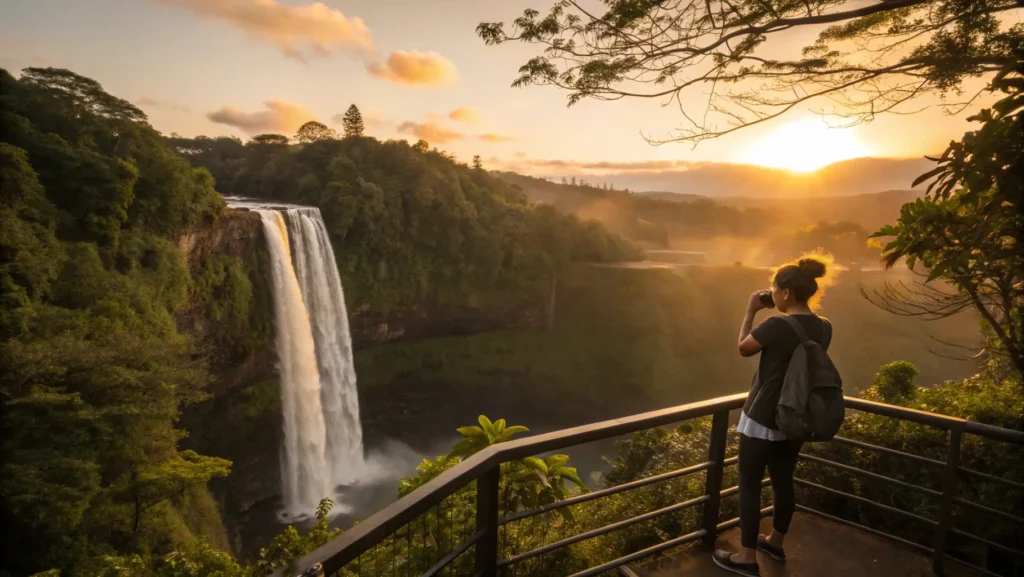
Conclusion & Call to Action
Wailua Falls represents Kauai at its most accessible yet magical—a place where the island’s wild beauty can be experienced just steps from your car. The falls offer a moment of natural wonder that stays with visitors long after they’ve left the Garden Isle.
As you plan your visit, remember that the best experiences come from respectful engagement with both the natural environment and the cultural context of this special place. The majestic double cascade of Wailua Falls has witnessed centuries of Hawaiian history and continues to inspire awe in all who visit.
We’d love to hear about your experience at Wailua Falls! Share your stories, tips, and photos with us in the comments below or tag your social media posts with #WailuaFallsKauai. Your insights help us keep this guide updated with the freshest information for future travelers seeking to experience one of Kauai’s true natural treasures.
Before you go, download our free East Kauai Waterfall Checklist to make the most of your waterfall adventures on the Garden Isle!
Mahalo for reading, and may your journey to Wailua Falls be filled with wonder and aloha.

